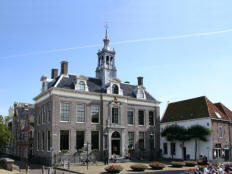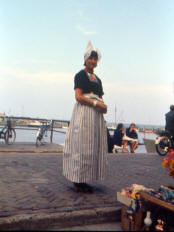Page 1 2 3 4 5 6 7 Tuesday, 16 June. We planned to get an early start to get to the flower auction at Aalsmeer, the world’s largest. The auctions are controlled by a large clock. As the time on the clock declines, so does the price of the lot being sold. The first person to bid gets the item at his price. If you wait too long, hoping for a lower price, you might get shut out. Unfortunately, as we left the Hotel Paap after breakfast, a delivery truck was stopped in the middle of the road on our only way out of our street. By the time he moved, we were very late. We got to Aalsmeer just as the last auction was ending. Most of the flowers were still there, though, so at least we got to see them. 
The bidding clock at Aalsmeer | 
Carts of flowers sold |

Cruquius Pumping Station |
Our morning continued to go badly. We drove to the Cruquius Pumping Station to see a demonstration of old-fashioned land reclamation, but the pump was broken so that was cancelled. It shouldn’t have been a surprise that the pump broke down. The station was built in 1846 to help drain the Haarlemmermeer. It’s a beautiful neo-Gothic building. The building, the engine and pumps have never been modernized. We were very sorry to miss this bit of engineering history. We drove about 15 miles to the beach area at Zandvoort, where we had lunch. Then we continued into Haarlem. We visited the Grote Markt, possibly the most attractive old market square in the Netherlands. It is surrounded by medieval buildings. Most notable of them was St. Bavo’s Church. We went in to see the huge and renowned Mueller organ (1736), a favorite of Handel. 
Jane in Haarlem's Grote Markt | 
St. Bavo's | 
Haarlem's Town Hall (Stadhuis) |

The boys checking out the Edam cheese |
We considered going to the Frans Hals Museum while we were in Haarlem. However, we had promised the boys that we wouldn’t make them go through any art museums, and we couldn’t think of any place to leave them. So we left Haarlem and headed northeast to Edam. Along the way we spotted four operating windmills. Before the land reclamation project, Edam was a fishing port. Now, of course, it’s most know for its cheese. The attractive little town is clustered around canals crossed by drawbridges and surrounded by canal houses and gardens. It’s dominated by St. Nicholas Church and the old Town Hall (1737). We also went through the quaint Sea Captain's House (18th century). 
Edam's Town hall (Stadhuis) | 
Canal through Edam | 
Typical Edam street |
We continued on to Volendam, another town whose inhabitants dress in the old way. We walked along the pretty waterfront and saw many costumes. 
Men along Volendam harbor | 
Dutch girl | 
Volendam waterfront restaurant |
We drove on to the nearby town of Marken, which has the same reputation for costumes. But it was 18:00 when we arrived, and the streets were deserted. It was still very light, so we walked around the narrow lanes to look at the houses. Marken is an island, and many houses are built on piles. Eventually, we came across a couple of
local men out for walk. 
Marken women on their back porches | 
Strolling in Marken
| 
This fellow even posed for us
|
We thought we would live it up and go to a famous restaurant in Monnikendam, right on our way back to Amsterdam. The French cuisine De Waegh is situated in a 1688 weigh house, complete with the original scales, and offers a view of the harbor, locks, and old inner city. The boys weren’t too enthusiastic about formal dining, though, and after one look at the prices, we decided not to eat there. We continued back to Amsterdam and had the rijstafel at another Indonesian restaurant. By then it was 21:00, and we went back to the hotel for the night. Page 1 2 3 4 5 6 7
Home
Copyright © 2000-2023 DarrellPeck.com All rights
reserved.
|